|
40. Satyrium w-album (Knoch, 1782) / White-letter hairstreak / Lycaenidae – Theclinae
NL: iepenpage / D: Ulmen-Zipfelfalter / F: thécla de l’orme, W-blanc
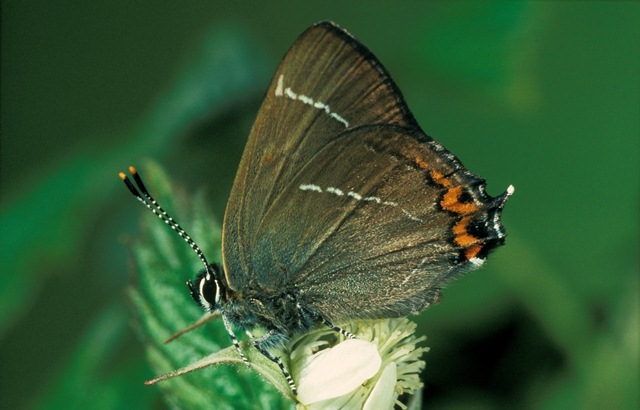 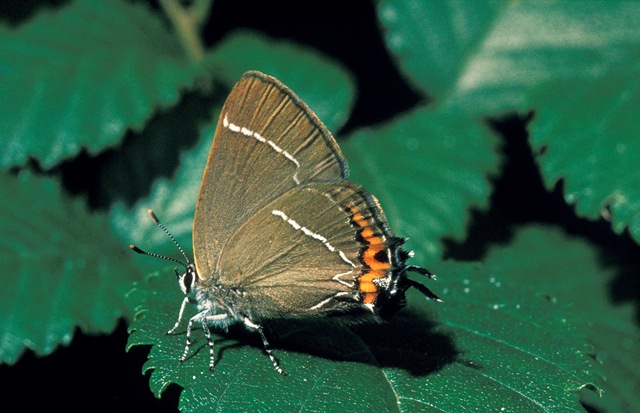 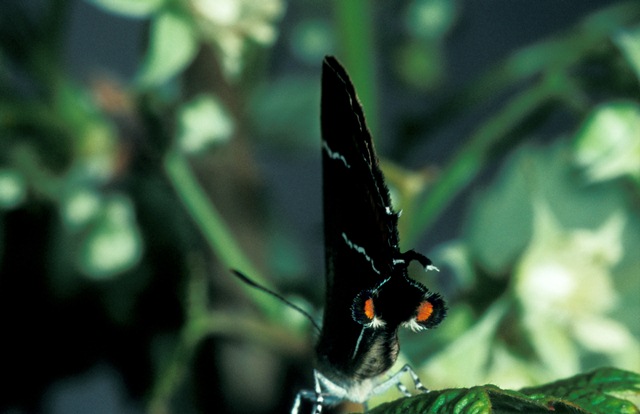
Photographs: Frits Bink ©.
Small, wing length 16 (15-16) mm. In the Benelux a scarce and locally occurring species that inhabits woods and parks, in the Netherlands only in the south of Limburg.
Butterfly is on the wing from mid-June until end-August. The species is known from localities in maritime and continental climates, amplitude 6 to 16. The required heat sum is 700°d and maximum tolerated 1800°d, the corresponding climate windows 24 and 35 weeks.
The adult butterflies are difficult to see because they stay most of the time high up in the canopy of a big tree and therefore the distribution of this species may be underestimated.
The species has been studied extensively in England because of the dramatic disappearance of its host plant, the elm tree, since the 1970’s, caused by the Dutch elm disease; it was feared that this would be disastrous for this butterfly.
This disease is spread by the bark beetle Scolytus acolytus and S. multitstriatus, which infect the tree with the fungus Ophiostoma ulmi for their food. Though there was a severe decline of the species in England, currently the situation looks a little better because the larvae are able to develop on suckers of the dead trees (Asher et al. 2001: 131).
Ecological characteristics
Behaviour over time
Overwintering: egg on twig near a bud, usually the terminal one.
Reproduction: oviposition starts after about 12 days when the body contains 30 (22-40) eggs. Estimated potential production 3 times as much.
Larval feeding periods: depends on the growing cycle of the elm. The eggs hatch before bud burst and, only if the tree develops flowers, do the larvae have food early in the season, otherwise they have to wait until leaf-buds burst, much later in the season.
Generations: always one.
Spreading of risk: not observed.
Life cycle: egg 30-43 weeks; larva 57 (37-78) days; pupa 15 (13-26) days.
Life span of adult: very long in female, up to 6 weeks, fairly long in male, about 3 weeks.
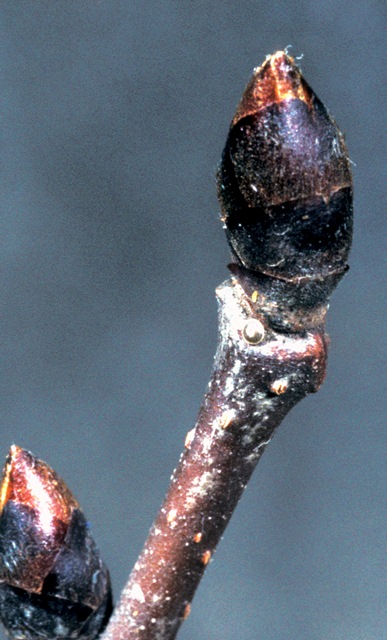 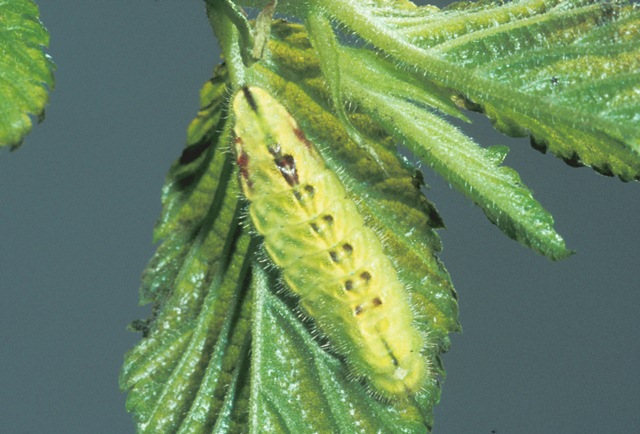
Photographs: Frits Bink ©.
Behaviour in space
From stay-at-home to migrant: stay-at-home, spatial requirement very modest.
Finding a mate: males and females gather in the canopy of a big tree, female has a conspicuous speculum.
Orientation in the landscape: any wood having elm trees or elm trees planted in an urban park.
Oviposition: on twig near the terminal bud.
Defence
Threats from other organisms: camouflage in the larval stage adjusted to the part of the host that is being used at the time, the larval colour changes from reddish in first instar to bright green in the last one.
Myrmecophily: attending by ants seldom seen in the northern countries (Asher et al. 2001: 130); however, in southern ones larvae attended by several ant species (Kan, pers. comm).
Threats from the environment: the species occurs only in sheltered sites, a sign that it is vulnerable.
Feeding habits
Adult: nectar of flowers in the herb layer, honeydew in the crown of a tree. Preferred herb flowers are umbellifers, marjoram etc.
Larva: the eggs hatch before bud burst and the fresh larvae have to wait for the buds to become assessable by bursting. Flower buds burst from end-February to early-March; however, when only leaf buds are available, it has to wait until mid-April. It changes from a bud-feeder to leaf-feeder and when fully grown its colour changes to brown so that is well camouflaged as it descends the tree to look for a pupation site.
Larval foodplants
Plant species: Ulmaceae: Ulmus glabra, U. laevis, U. minor.
Journal
Rearing experiment based on specimens originated from Bayern:
28 March 1985: three larva collected in the field.
28 April 85: two larvae ate young leaf, one ate wings of the seed.
4 May: two larvae changed colour from green to brown and then perfect camouflaged for moving on the bark to creep away into a fissure of the bark to pupate.
6 May: one larva had spun a girdle, last larva is now prepupa.
8 May: two pupated, one between leaves.
21 May: first adult appeared, male (pre-pupa four days, pupa 15 days).
23 May: second adult appeared, male.
25 May: third adult, female.
31 May: copulation observed.
5 June: adults lethargic because it was too hot in the greenhouse.
12 June: dead, one egg laid, life span of the female was 18 days.
Table 40-1. Results of dissections

Table 40-2. Collection and observation localities
F, Bois de Desvres 50° 41’N – 1° 49’E; 1 September 1980 (old female).
D, Lichtenfels 51° 09’N – 8° 47’E; 13 April 1986 (larva in a recently opened flower bud).
S, Bräkne-Hoby, Blekinge folkhögskola 56° 13’ 30”N – 15° 07’ 23”E; 12 June 1984 (larva on elm sucker).
S, Gräsö 60° 20’ 52”N – 18° 28’ 30”E; 17 August 1985 (old female on Fraxinus).
S, Öland, Frösslunda 56° 32’ 34”N – 16° 35’ 12”E; 22 July 2004 (adults on marjoram).
Fig. 40-1. Satyrium w-album, phenogram adapted from Fichefet et al. 2008: 155.
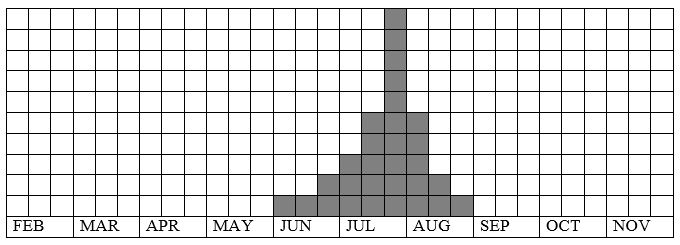
Fig. 40-2. Satyrium w-album, habitat characteristics.
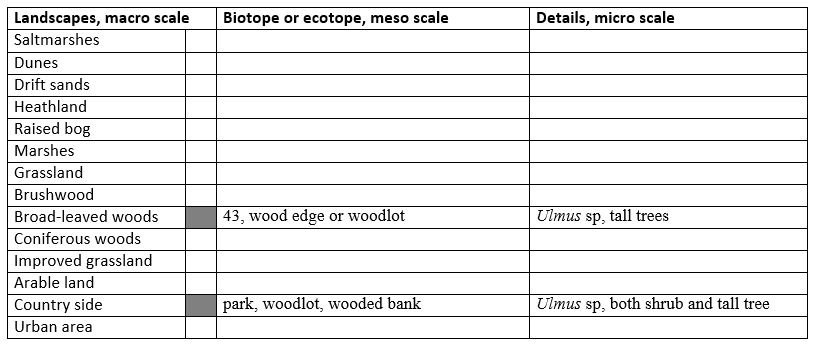
Fig. 40-3. Satyrium w-album, climate matrix, heat-sums 700 - 1800°d.
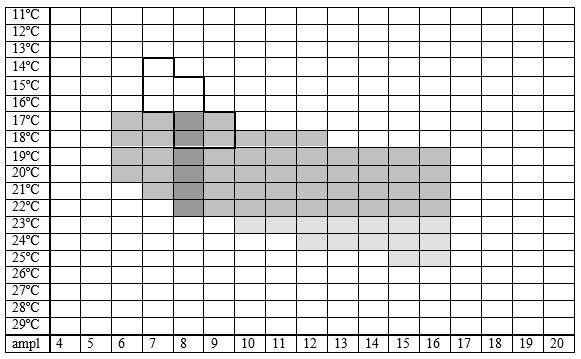
|










